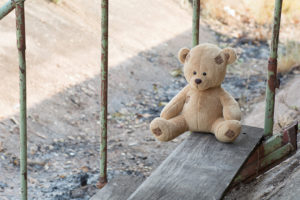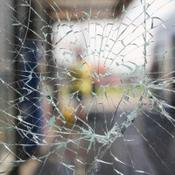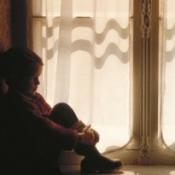 Researchers have studied the impact of early childhood trauma and the long-term effects of abuse and neglect for decades. Evidence suggests that early experiences of maltreatment often put children at a higher risk for developing physical and mental health issues that sometimes extend into or manifest later in life. Studying the relationship between child abuse and domestic violence, however, has led to more questions than answers in some cases. Are perpetrators of domestic violence more likely to abuse their children, and are kids who have been exposed to intimate partner violence (IPV) more likely to grow up and repeat the cycle? Where is the overlap and how can identifying it help with future interventions to prevent childhood trauma?
Researchers have studied the impact of early childhood trauma and the long-term effects of abuse and neglect for decades. Evidence suggests that early experiences of maltreatment often put children at a higher risk for developing physical and mental health issues that sometimes extend into or manifest later in life. Studying the relationship between child abuse and domestic violence, however, has led to more questions than answers in some cases. Are perpetrators of domestic violence more likely to abuse their children, and are kids who have been exposed to intimate partner violence (IPV) more likely to grow up and repeat the cycle? Where is the overlap and how can identifying it help with future interventions to prevent childhood trauma?
A Study of IPV and Adverse Childhood Experiences
According to a report published by the United States Department of Health and Human Services (2013), there were an estimated 679,000 victims of child abuse and neglect in 2013. That means roughly 9 out of every 1,000 children experience some form of abuse or neglect each year. Child abuse comes in many forms and is often defined as the nonaccidental injury or pattern of injuries to a child, including those of an emotional, physical, or sexual nature.
Intimate partner violence can be expressed in different forms as well. According to an article published by the National Council for Family Relations, sociologist Michael P. Johnson, PhD identifies three distinct types of IPV:
- Intimate terrorism: violence used for control
- Violent resistance: a violent response to a partner’s attempt to control
- Situational couple violence: violence not intended for control, but arises as a result of escalated conflict
Because of the varying forms of both child abuse and IPV, researching a link between the two is tough and often inconclusive in terms of identifying an exact link or correlation. However, there are some aspects of existing research that may shed light on a relationship. After analyzing several studies on different types of IPV, Johnson discovered:
- The risk of child abuse in families that don’t experience IPV is about 15%.
- In households where situational couple violence occurs, there is a 31% risk for child abuse.
- Families experiencing intimate terrorism have a 67% increased risk for co-occurring child abuse.
Based on the available research and literature, there does appear to be enough information to support the idea that where there is domestic violence, there may be an increased risk for child abuse. Regardless of the exact connection between the two, it is evident that whether children experience child abuse, intimate partner violence, or both, the short-term and long-term effects of abuse and violence can be devastating. Victims of abuse may be at risk for physical, emotional, behavioral, and cognitive problems, including impaired brain development, emotional health issues, social difficulties, substance abuse, and abusive/violent behavior.
An ongoing study, conducted by the Division of Violence Prevention of the Centers for Disease Control and Prevention, was designed to investigate the consequences of childhood exposure to certain traumatic stressors. The Adverse Childhood Experiences (ACE) Study, a survey with more than 17,000 participants, found that the more adverse childhood experiences people were exposed to, the more likely they were to develop health issues later in life. More specifically, experiences such as abuse, neglect, or household dysfunction (e.g. witnessing domestic violence) were risk factors that increased the likelihood of issues such as alcohol abuse, intimate partner violence, or depression as an adult. The ACE Study, and others like it, seek to uncover similar relationships so violence prevention efforts can more effectively target risk factors for abuse and domestic violence.
Interrupting Cycles of Violence
It should be noted that many children who are abused or witnesses domestic violence will grow up without ever repeating the same violent behavior, but when taking the harmful effects of abuse and domestic violence into consideration, it can be hard to ignore the way they can contribute to a cycle of abuse. From a purely sociological perspective, the effects of abuse, neglect, and domestic violence are also some of the same factors that contribute to This is one of many reasons why understanding the relationship between domestic violence and child abuse is so important. Treatment and prevention initiatives depend on it. Social services, educational and mental health professionals, researchers, and other child welfare advocates are all striving to impact positive change when it comes to children and their safety.the perpetuation of abuse. For example, if a child was physically abused by an alcoholic parent, that child is statistically more likely to use drugs or alcohol as an adult. Research shows that substance abuse is often a precipitating factor in cases of domestic violence and child abuse. The reality is usually more complex, but without intervention there is a heightened risk that a cycle of violence may continue.
For some children, protective factors such as a supportive relationship with an adult, high self-esteem, or high intelligence add to the child’s ability to survive and thrive after abuse, which is sometimes referred to as resiliency. Promoting resiliency can help interrupt a cycle of abuse that can occur in family systems for generations.
This is one of many reasons why understanding the relationship between domestic violence and child abuse is so important. Treatment and prevention initiatives depend on it. Social services, educational and mental health professionals, researchers, and other child welfare advocates are all striving to impact positive change when it comes to children and their safety. The current solutions being implemented tend to focus on reporting, supporting, and prevention. In addition to reporting procedures and agency enforcement of the law, support for those who have experienced abuse can promote healing and prevention. Many types of trauma-informed care—including individual, couples, and family therapy—can effectively address issues associated with abuse, neglect, or domestic violence.
Laura Reagan, LCSW-C, a licensed certified social worker who works with abuse survivors in Annapolis, Maryland, uses several trauma-informed techniques in her therapy practice. “When working with individual clients who are survivors of domestic violence … I use therapeutic techniques focused on addressing trauma. These may include strengths-based, client-centered talk therapy techniques, crisis intervention strategies, psychoeducation about trauma and the dynamics of healthy and unhealthy relationships, expressive arts modalities, and somatic resourcing.” Reagan has also found non-directive play therapy and trauma-focused cognitive behavioral therapy helpful in her work with children who have experienced abuse.
When it comes to intimate partner violence, interventions should be chosen carefully. In many intimate terrorism cases, for example, couples therapy may not be an option. In less severe situations, couples are sometimes able to work with a qualified therapist. Additionally, there may be an opportunity to include children in family therapy, provided the safety risks are thoroughly weighed and the parents are genuinely invested in change.
Seeking Help or Resources for Domestic Violence or Abuse?
Those interested in accessing therapy should make sure to utilize the help of qualified, trained professionals. When it comes to abuse and domestic violence, safety is paramount. People are most at risk when they seek help or try to leave an unsafe situation. Seeking good resources and support to help with the process can make a big difference. For those looking for help, here are some places to start:
- For more information on child abuse, mandated reporting, and local resources for families experiencing abuse and neglect, visit childwelfare.gov.
- For information on how to ensure the physical, mental, and social health of your child, visit healthychildren.org. Here you can find parenting resources, general health information, and more.
- Dedicated to the prevention of child abuse, childhelp.org/hotline/ manages the National Child Abuse Hotline at 800-4-A-CHILD. The hotline offers crisis intervention, information, literature, and referrals to thousands of emergency, social service, and support resources. All calls are confidential and interpreters are available to assist in more than 200 languages.
- For adults and families experiencing intimate partner violence, thehotline.org/ hosts the National Domestic Violence Hotline at 800-799-SAFE (7233) or 800-787-3224 (TDD). Trained advocates provide support and assistance and can help connect people to local shelters and agencies who specialize in domestic violence.
If you are seeking help or resources for domestic violence or abuse online, please be mindful that many perpetrators of abuse monitor their victims’ online activities. Clear your browser history or use a secure search function that doesn’t record your history to ensure your safety.
References:
- Adverse Childhood Experience Study. (n.d.). Centers for Disease Control and Prevention. Retrieved from http://www.cdc.gov/violenceprevention/acestudy/
- Carter, J. (n.d.). Domestic Violence, Child Abuse, and Youth Violence: Strategies for Prevention and Early Intervention. Minnesota Center Against Violence and Abuse. Retrieved from http://www.mincava.umn.edu/link/documents/fvpf2/fvpf2.shtml
- Child Abuse Facts. (n.d.). Safe Horizon. Retrieved from http://www.safehorizon.org/page/child-abuse-facts-56.html
- Child Maltreatment 2013. (2013). Administration for Children and Families. Retrieved from http://www.acf.hhs.gov/sites/default/files/cb/cm2013.pdf
- Children’s Bureau. (2013, July). Long-Term Consequences of Child Abuse and Neglect. Children’s Bureau Information Gateway. Retrieved from https://www.childwelfare.gov/pubpdfs/long_term_consequences.pdf
- Johnson, M. P. (n.d.). Domestic Violence and Child Abuse: What Is the Connection—Do We Know? National Council on Family Relations. Retrieved from https://www.ncfr.org/ncfr-report/focus/child-abuse-neglect/domestic-violence-and-child-abuse-what-connection-do-we-know
- Types of Child Abuse. (n.d.). Adults Surviving Child Abuse. Retrieved from http://www.asca.org.au/WHAT-WE-DO/Resources/General-Information/Types-of-child-abuse
- What to Know about Child Abuse. (2015, August 20). org. Retrieved from https://www.healthychildren.org/English/safety-prevention/at-home/Pages/What-to-Know-about-Child-Abuse.aspx
© Copyright 2015 GoodTherapy.org. All rights reserved. Permission to publish granted by GoodTherapy.org Staff
The preceding article was solely written by the author named above. Any views and opinions expressed are not necessarily shared by GoodTherapy.org. Questions or concerns about the preceding article can be directed to the author or posted as a comment below.

 Big T and Little t Trauma and How Your Body Reacts to It
Big T and Little t Trauma and How Your Body Reacts to It We Need to Talk about Domestic Violence in Our Communities
We Need to Talk about Domestic Violence in Our Communities Secondhand Hurt: The Impact of Domestic Violence on Children
Secondhand Hurt: The Impact of Domestic Violence on Children